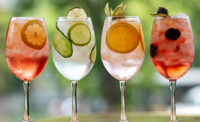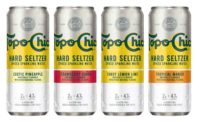ADM: Hard Seltzer Solutions
ADM identifies three differentiators in fast-growth hard seltzer market

PHOTO CREDIT: AbobeStock images courtesy of ADM

PHOTO CREDIT: AbobeStock images courtesy of ADM


The hard seltzer market has grown exponentially since the segment first popped up around 2016. Hard seltzers are viewed as fresh ready-to-drink (RTD) alcohol options with gender-neutral and better-for-you appeal. Pairing low-calorie and low-sugar attributes in a gluten-free, refreshing beverage during the flavored sparkling water boom has caused hard seltzers to become a consumer favorite, particularly with millennials1. These days, the hard seltzers segment is facing saturation, as new formulations and brands continually enter the competition, hoping for a taste of the impressive returns.
To stand out in this effervescent market, manufacturers must differentiate their products, particularly as many hard seltzer consumers are brand loyalists1. There is opportunity, however, as 46% of shoppers are willing to try other brands1. Above all, consumers are seeking hard seltzers that taste great. In fact, 35% of consumers rank flavor as the most important priority when considering hard seltzer purchases2. Second to that is alcohol by volume (ABV) and third is calories per serving2. To capture consumer audiences, developers need to find new ways to build in delicious flavor while ensuring calories are low, all without diluting their offerings.
Sparkling Sensory Experience
The broad interest in today’s hard seltzers suggests they are more than a passing fad. Consumers expect more in terms of flavor and performance—including a clean taste and less sugar. However, the finished product varies depending on the alcohol base used to produce these bubbly beverages, whether they are spirit-, wine-, malt- or sugar-based.
Distilled spirits have a perceived clean taste, but hard seltzers are brewed like beer, without distillation, and they do not always provide the desired taste or overall sensory experience. Hard seltzers that have a clean color and pour out of the can with exceptional transparency are more likely to resonate with consumers.
Within the alcohol industry, sugar-based seltzers are leading the pack. The current market share of RTD alcohol by base includes 53% for sugar base, 31% for malt base, 15% for spirit base and 1% for wine base3. Plus, sugar-based RTD alcohol is anticipated to grow by a CAGR of 20.5% by 20253. Sucrose, derived from cane or beet sugars, is a common base for hard seltzers though it brings its own share of challenges and processing requirements that may slow down production.
Formulators that leverage a simple sugar like ADM’s Liquid Dextrose Edge will be pleased with its ease-of-use as a drop-in fermentation solution that does not require additional processing, keeping capital costs low. Liquid Dextrose Edge delivers clear color and clean taste and also produces fewer residual sugars post-fermentation than sucrose. Pairing a clean and clear sugar base with flavors derived from natural sources can elevate the sensory experience.
Intensifying Alcohol Content
As the hard seltzer market continues to expand and evolve, stronger seltzers are emerging on the scene. While hard seltzers started out as easy drinking, low ABV alternatives, the segment is starting to include buzzier beverages with higher ABVs. Global brands and craft brewers alike are getting into the hard seltzer game, which may be part of the reason some new product launches are amping up from 4% ABV to 5% or higher. For hard seltzers to win over the stronger beer drinkers of the world, higher ABVs can be a helpful differentiator.
Achieving a higher ABV while optimizing production with rapid fermentation rates and high attenuation can be difficult with sucrose as an alcohol base. Processing efficiencies rely on a higher real degree of fermentation (RDF) and lower real extract to alcohol ratio (RE/Alcw).
In other words, manufacturers aim to decrease residual sugars and increase yeast productivity, accounting for reduced loss of product and better asset utilization. Moreover, brewing a higher ABV can affect calorie content in the finished product. Fermentation yields unconverted sugars (fructose and dextrose), and these additional sugars also add calories.
Fizzling Out the Calories
Today’s consumers are evaluating product labels across categories, and the number of calories is a key factor for many shoppers. Beverages are highly scrutinized, with 56% of U.S. adults saying they review beverage nutrition fact panels and 53% reviewing beverage ingredient lists4. With beverages, especially those that are fermented, deriving a portion of their total calories from added sugars, options that have fewer sugars and calories are delivering on consumer demand. So as shoppers scan hard seltzer product labels for a desired ABV and calorie count, they’re also checking for the alcohol listed on the ingredient label and avoiding an abundance of sugar.
Hard seltzer brands that partner with a global supplier that provides quality solutions, a wide portfolio and technical expertise will be poised for success with consumers. They’re also more likely to capture new shopper attention in the ever-expanding hard seltzer category.
Rishi Shukla is a research fellow at ADM’s Science & Technology Center. Contact ADM to learn more about ADM’s fermentation science.
Notes:
1ADM Outside Voice℠, Hard Seltzer Market Exploration Study, January 2021
2ADM Outside Voice℠, Hard Seltzer Consumption, November 2021
3Euromonitor International. NA. RTD Alcohol, May 2022
4ADM Outside Voice℠, Consumers & Sugar Reduction, August 2020
About ADM
ADM unlocks the power of nature to enrich the quality of life. We’re a premier global human and animal nutrition company, delivering solutions today with an eye to the future. We’re blazing new trails in health and well-being as our scientists develop groundbreaking products to support healthier living. We’re a cutting-edge innovator leading the way to a new future of plant-based consumer and industrial solutions to replace petroleum-based products. We’re an unmatched agricultural supply chain manager and processor, providing food security by connecting local needs with global capabilities. And we’re a leader in sustainability, scaling across entire value chains to help decarbonize our industry and safeguard our planet. From the seed of the idea to the outcome of the solution, we give customers an edge in solving the nutritional and sustainability challenges of today and tomorrow.
Looking for a reprint of this article?
From high-res PDFs to custom plaques, order your copy today!







